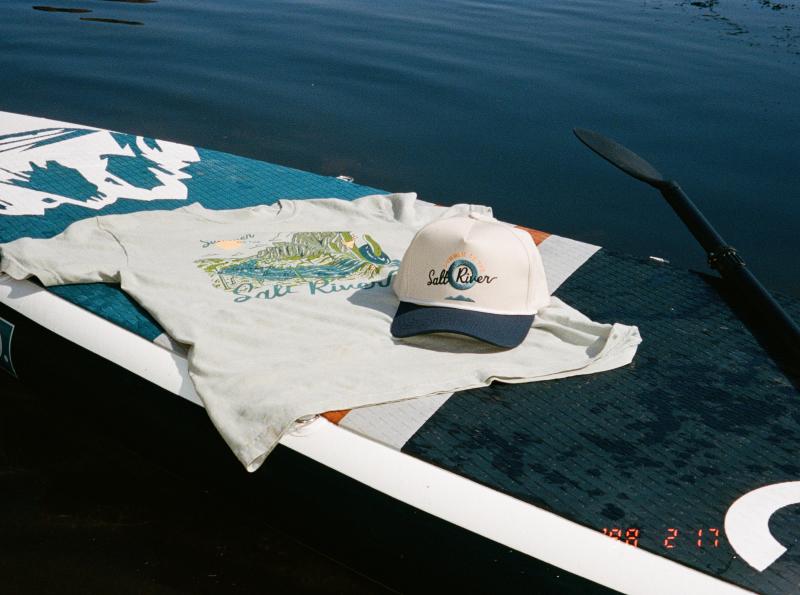The Salt River
Arizona's iconic Salt River has been a source of innovation and recreation for Greater Phoenix residents area for thousands of years. The 200-mile river provides much of the water supply for Greater Phoenix, thanks to canals, pipelines and reservoirs — the latter of which creates many of the nearby lakes that we enjoy: Saguaro, Canyon, Apache, and Roosevelt lakes all act as reservoirs for the Salt River.
The best-known segment of the river (formally the Lower Salt River) is located about 40 minutes from downtown Phoenix in Mesa, where visitors and locals go mainly for two reasons: tubing and wild horses. We'll tell you everything you need to know to enjoy your experience on the river, including what to bring, when to go and other things to do.
Because the Lower Salt River is located in the Tonto National Forest, you will need to purchase a recreational day pass to explore the area. Passes, which cost $8, can be purchased at multiple stores and gas stations throughout Greater Phoenix, as well as directly on site. Find nearby gas stations in the map below.
Salt River Tubing
Back to Top of ListSpending a day tubing the Lower Salt River is easily one of the most popular summer activities in the Greater Phoenix area. You'll see a mix of families, couples and friends bringing along waterproof speakers, coolers filled with plenty of drinks and snacks, and everything else you need to enjoy the real-life lazy river. For tubing pros, you'll notice groups have their tubes tied together with rope to make sure they don't get separated.
Arizona's Salt River Tubing & Recreation
Arizona's Salt River Tubing & Recreation is your one-stop shop to experience some Salt River tubing. The service — which operates from May to September — provides you with a rental tube to float in as well as a shuttle to drop you off and pick you up for $28 (plus tax). Rentals are available daily from 9 a.m. to 2 p.m. (The rental services is open until 6 p.m. to return tubers on the shuttle.)
9200 N. Bush Highway, Mesa
480-984-3305
saltrivertubing.com
Go Tubing Independently
If you'd prefer to avoid the crowds, fees and occasional wait times, you can always opt to go Salt River tubing independently. You'll need to bring your own inner tube, of course, but you'll also need to bring two cars — leave one parked at your starting point and the other parked at your ending point — otherwise you might be in for a long walk.
There are six recreation sites with parking lots along the Lower Salt River (Arizona's Salt River Tubing & Recreation stops at four of them): Water Users, Blue Point, Goldfield, Coon Bluff, Phon D Sutton and Granite Reef.
Salt River Kayaking
Back to Top of ListWhile tubing brings the majority of river guests, there are plenty of people who enjoy kayaking and stand-up paddleboarding (SUP) along the Lower Salt River. The river is perfect for either experienced or first-timer paddlers, since you can just let the river's current gently lead you downstream and enjoy the views. Most kayakers and paddleboarders opt for early morning river rides for several reasons: you can beat the heat, avoid the tubing crowds, and increase your chances of spotting the area's famed wild horses (more on that below).
Like tubing, kayaking and paddleboarding along the Lower Salt River can be done independently or with a guide. Check out Riverbound Sports Paddle Co., who schedule guided tours as well as provide rentals. For those who are looking for something a bit more extreme, Arizona Rafting hosts whitewater rafting tours further north in the Salt River Canyon.
A leisurely float puts river goers up close to wild mustangs, blue herons and bald eagles.
Read MoreSalt River Wild Horses
Back to Top of ListAs if the beautiful scenery surrounding the Lower Salt River wasn't enough, one of the most jaw-dropping sights found along an 18-mile stretch of the river are the wild horses — also known as mustangs — who call the river home. The horses roam along the banks where many visitors kayak and tube, and can easily be spotted along your route, depending on the time of day.
Where did the Salt River wild horses come from?
Research suggests that the wild horses are descendants of Spanish horses, brought to Arizona in the 17th century by Spanish missionary Father Eusebio Kino. The Tonto National Forest was established in 1902, and the horses had long been living in the area by then. The Bureau of Land Management estimates that there are less than 500 wild horses remaining in Arizona.
Though it is not a native species, the wild horses are protected under the Salt River Horse Act, enacted into law in 2016.
Where can I see Salt River wild horses?
You can spot the wild horses throughout the 18-mile stretch of the Lower Salt River that encompasses the six recreation areas, but historically, the horses are most commonly seen at spots close to Saguaro Lake, including Phon D. Sutton Recreation Area, Granite Reef Recreation Area and Coon Bluff Recreation Area.
Because the horses are looking to avoid the summer heat and cool off as much as we area, they are most often seen within two to three hours of sunrise and sunset, when the weather is cooler. If you go out for an early morning kayak or float, you'll most likely spot a few along your ride.
Remember, these horses are wild animals. Make sure to be respectful of their space, not to feed them, and if you've brought your dog along, make sure it's leashed and doesn't approach the horses.
FAQs
Back to Top of ListHow long does it take to go down the Salt River?
Depending on where you start and stop, it takes anywhere from two to six hours to venture down the lower Salt River.
Is Salt River safe to swim in?
You can swim in the Salt River, but be aware that the water is not as clean as your typical swimming pool because of all the folks and animals who use the river daily. If you do decide to swim, try to avoid ingesting any water.
Are there rapids?
The Lower Salt River is primarily Class I rapids, one of which can approach Class II during certain flow rates. If it's Class III and IV rapids you're after, you'll find world-class whitewater recreation on the Upper Salt River. Please note: Although the names are very similar, these two segments of the river are very different and the Lower Salt River is perfect for all skill levels. Something you can do to make sure you're prepared for any rapids is keep an eye on kayakers and tubers ahead of you to see where the flow of water is going.
Is the Salt River dangerous?
The Salt River is not dangerous, but you should still prepare for an outdoor adventure. Here’s some things you’ll likely need:
-
Water shoes: the river is not all that deep, so your feet will touch the riverbed at some point. It can be rocky and mossy, so have some shoes that can handle that terrain.
-
Sunscreen: chances are you're going to the river during summer, and as you know, it gets hot! Make sure you have plenty of sunscreen and apply it often.
-
Water: even though the Salt River can be a leisurely ride, it's still important to hydrate and have plenty of water.
-
Dry bag or waterproof storage: you don't want your phone to get wet! Have something with you to make sure it stays dry so you can get some sweet photos.
-
A sheet or large towel: Wet it and drape it over your tube for a comfy barrier between your skin and the hot black rubber of the tubes.
Salt River Souvenirs & Gifts: Shop the Visit Phoenix Collection

Love the Salt River as much as we do? Commemorate your float with exclusive Salt River-inspired merch from Visit Phoenix. From locally designed apparel to accessories perfect for desert days, these items celebrate one of Greater Phoenix’s favorite summer traditions:
-
Reversible Bucket Hat – Two looks in one, made for sunny float days.
- Salt River Hats – Choose from classic cream or navy styles to rep your river time all year long.
- Summer on the Salt River Tee – A soft, breathable shirt that captures the laid-back vibe of floating season.
Editor's Picks
Shop Visit Phoenix's Online Store
Shop for exclusive, limited edition merchandise inspired by the vibrant energy of Phoenix, Arizona…
6 Lakes Near Phoenix
Phoenix has a number of lakes just a short drive away and they all provide something fun for both…
Where to See a Saguaro Cactus in Phoenix
Learn some fun facts about the iconic desert plant, and check out spots like Desert Botanical…








